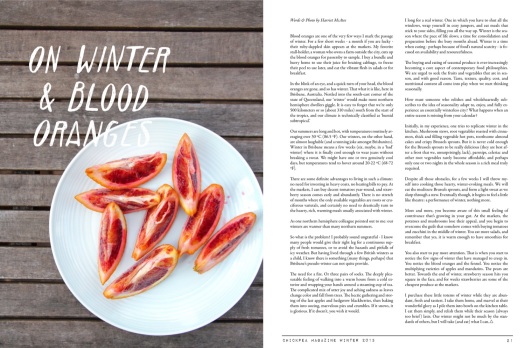Today I’ve got something I’m very excited to share with you: a recipe to go along with my article that appears in Chickpea’s new Winter 2013 edition! Haven’t heard of Chickpea? It’s the sweetest vegetarian and vegan quarterly floating around – gorgeous photos, writing and so many amazing ideas! I’m so grateful and excited to be involved. If you like, you can grab a copy in their online store (for now, only the digital copy is available, but the print version should be out soon!).
I won’t spoil the gist of my article for you, but it’s a very Harriet-style musing on winter. When I started thinking about this piece, I really asked myself what signifies winter to me – what evokes its shorter days and cooler nights? Blood oranges immediately came to mind – they’re one of my favourite fruits, and I love them all the more for their limited season. You appreciate them all the more, I find.
This salad – something I find myself making regularly when blood oranges are in season – is seriously delicious. Filling, flavourful and also a feast of colour for your eyes – just check out all that orange! Need I mention that it’s packed full of nutrients? Probably not (even though it is!).
Wherever in the world you might be, I hope you’re enjoying the change in seasons. Here, winter has gone and we’re heading full-throttle into summer. I’m almost wishing for those cooler days again.



blood orange + sweet potato salad w blood orange citronette
serves 4
recipe notes
- If you’re not sure how to supreme a blood orange, check out the instructions below.
ingredients
for the salad
- 4 sweet potatoes (900 g / 2 lb)
- 1 sprig rosemary, leaves removed
- 2 tbsp olive oil
- a pinch of sea salt
- freshly cracked black pepper
- 1/3 c (45 g) pepitas (pumpkin seeds), toasted
- 1 c (160 g) cooked cannellini beans (tinned is fine)
- 2 blood oranges, supremed
- 4 stems of dill, fronds removed and roughly chopped
for the citronette
- 1/3 c (80 ml) blood orange juice (from 1 orange)
- 2 tbsp olive oil
- a pinch of sea salt
- freshly cracked black pepper
- 1/4 – 1/2 tsp apple cider vinegar (to taste)
Preheat your oven to 190 C (375 F) and line an oven tray with parchment paper. Quarter the sweet potatoes lengthwise, then cut into 2 inch segments. In a large bowl, toss sweet potatoes with rosemary leaves, oil, salt and pepper. Spread onto baking tray in a single layer. Place into the oven and roast for 35 minutes, until soft. Allow to cool slightly before assembling the salad.
Meanwhile, make the citronette by combining all the ingredients in a glass jar, seal with a lid and shake to combine (or whisk together in a bowl). Adjust seasoning to taste if necessary.
In a large bowl, combine roasted sweet potato with pepitas, beans, blood orange segments, and dill. Pour over dressing and mix gently to coat. Serve and enjoy.
how to supreme a blood orange
- Using a sharp knife, slice off the ends of the blood oranges, to reveal the top of the flesh.
- Turn the orange so one of the flat ends is down on the cutting board, and slice between the flesh and the pith, moving around the orange in sections, until the skin and pith is removed.
- Pick up the orange, and slide your knife between the membrane and flesh of one segment. Repeat on the other side of that segment, loosing it from the orange.
- Repeat step 3, working you way around the orange until all the segments are free from the membrane.





































































